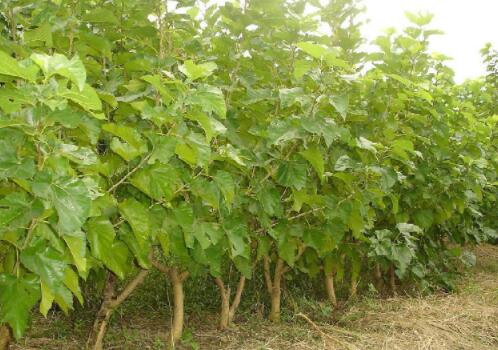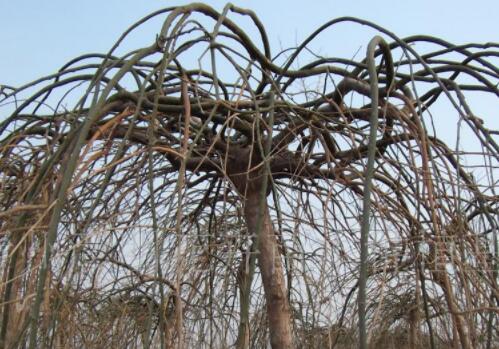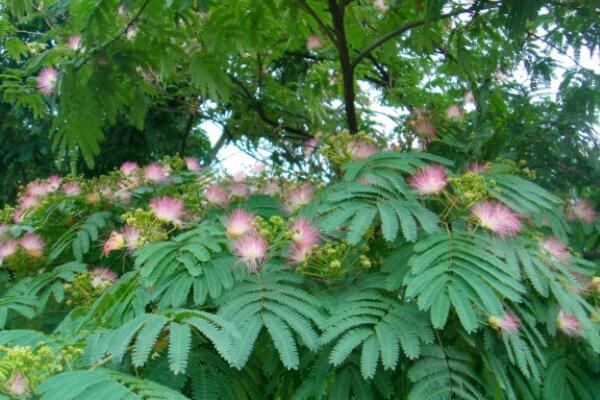How much is the price of shrubs and mulberry seedlings? Which kind of output is high? What is the use value at present? How to plant and prune?
Mulberry generally refers to mulberry, mulberry deciduous trees or shrubs, up to 15 meters high. The tree body is rich in milk and the bark is yellow brown. Flowers may, catkins. Fruit ripening period: June to July. How much does that mulberry seedling cost? Which produces more? What is its current value? How to plant pruning? From Jiangsu nursery base learned that the height of 60CM price in 0.9 yuan/tree; 100 CM in 1.2 yuan/tree;150CM in 1.8 yuan/tree.

Mulberry seedlings which kind of high yield?
Traditional mulberry varieties were bred for the purpose of collecting leaves and raising silkworms, and could not form large-scale industrial production because of no mulberry fruit or small fruit. Now a series of mulberry varieties with large fruit shape and high fruit yield have been bred.
Mulberry: seedless big 10, red fruit 2, white jade king, Fuji red, Taiwan long mulberry fruit, Taiwan four seasons mulberry fruit and so on.
Sericulture: mulberry, sea mulberry, mulberry, lake mulberry, mulberry, dragon mulberry, autumn mulberry, etc. Traditional mulberry varieties were bred for the purpose of collecting leaves and raising silkworms, and could not form large-scale industrial production because of no mulberry fruit or small fruit. Now a series of mulberry varieties with large fruit shape and high fruit yield have been bred.
What is the current value of mulberry trees?
Mulberry for Moraceae deciduous trees, cultivated throughout the country, especially in Jiangsu and Zhejiang areas, and has a long history. Mulberry leaves, fruit, wood, branches and so on can be used to feed silkworms, food, wine, basket weaving, paper and make all kinds of appliances, while its leaves, roots, bark, twigs, ears, wood, parasites and so on or disease control medicine
1, mulberry leaves: mulberry leaves, to harvest after frost is better, called frost mulberry leaves or winter mulberry leaves. It tastes bitter sweet and cold, enters the lung and liver meridians, has the functions of dispersing wind and clearing heat, cooling blood to stop bleeding, clearing liver and improving eyesight, moistening lung and relieving cough. It is often used to treat wind-heat cold, lung-heat cough, liver-yang headache, dizziness, red eyes, blood-heat bleeding and night sweats. It is also used in modern times to treat elephantiasis of the lower limbs. It can be taken orally and externally, and has also been made into injection. In addition, the fresh mulberry leaves after picking broken veins to take its exudation of white juice, medicine name called mulberry juice, bitter slightly cold, good at detoxification clear blood, treatment carbuncle furuncle, gall tumor, traumatic bleeding and centipede bite. The distilled liquid of mulberry leaves can also be used to treat eye diseases.
2, mulberry branches: mulberry shoots, late spring and early summer harvest. Its nature taste bitter flat, partial into the liver meridian, good at dispelling rheumatism, through the meridians, joints, circulation of moisture. It is mostly used to treat rheumatism pain, limb spasm, edema, itching and other syndromes, especially for upper limb pain. It can be decocted in soup or cream for internal use, or decocted in water for external washing. In addition, after burning mulberry branches, can leach juice, named mulberry juice,"Compendium of Materia Medica" and other books contain its can treat "wind scabies", tetanus, children's body and face sores and other cards.
3. Mulberry root: The mulberry root is dug in winter and its cork is removed for medicinal purposes. Sweet and cold in nature, enters lung and spleen meridians, has the effect of purging lung and relieving asthma, and promoting water detumescence. It is often used to treat cough, phlegm, edema, beriberi and dysuria. More into the decoction, powder, also pound juice or decoction for external use. Mulberry root with skin can also be used as medicine, the book contains its taste slightly bitter nature, can treat epilepsy, muscle pain, hypertension, red eyes, thrush, metrorrhagia and so on. In addition, the white juice in the whole mulberry bark is called mulberry bark juice, which can cure aphtha and traumatic bleeding in children.
4. Mulberry: for mulberry fruit cluster, summer harvest. Sweet and cold in nature, belongs to the heart and kidney meridians, has the functions of tonifying liver and kidney, nourishing yin and blood, moistening intestines and calming wind. It is often used to treat dizziness, dark eyes, tinnitus, insomnia, early white hair, thirst due to body fluid injury, constipation due to intestinal dryness, etc. Decoction, decoction, raw food, wine immersion, washing can be used outside.
5, mulberry wood: mulberry wood medicine has three uses, one is the ash burned by wood, called mulberry wood ash, can treat edema, golden sore bleeding, red eye swelling and so on. The second is mulberry ash water system juice, after filtration, evaporation obtained after the crystallization, named mulberry frost, can treat choking block and carbuncle furuncle poison. Third, the old mulberry wood nodules, named mulberry gall, the ancients thought that can dispel wind dehumidification, cure rheumatism arthralgia, old crane knee wind and so on. It is a pity that mulberry trees are now rarely used clinically.
6. Mulberry parasite: Auricularia parasitized on mulberry trees. The ancient medicine book is called mulberry ear. It tastes sweet and flat. It can treat intestinal wind, hemorrhoids bleeding, epistaxis and women's metrorrhagia, leucorrhea, abdominal pain, etc. In addition, the current clinical common Taxillus parasiticus for many kinds of plants branches and leaves, but the ancients thought that parasitic mulberry is better, its bitter taste into the liver and kidney meridians, good at dispelling rheumatism, tonifying liver and kidney, strengthening bones and muscles, nourishing blood and preventing pregnancy. It can be used to treat rheumatism, waist and knees pain, metrorrhagia, leukorrhagia and fetal restlessness.
How to plant mulberry trees?
Planting techniques:
1. Sowing method
The first step is to select and adjust the seedling land. It is advisable to select fertile and loose sandy loam with convenient drainage as nursery. 4~6 days before sowing, it is best to spray herbicides comprehensively. 2~3 jin chlordane powder pesticide can be sprayed on each mu of ground. Then rake the land horizontally and horizontally. The ridge of 4 inches high and 4 feet wide is generally selected according to the drainage conditions. The ridge surface should be finely divided and leveled.
Mulberry seeds should be sown as soon as possible after purchase, and each seed should be mixed with five parts of fine soil (if the land is not sprinkled with pesticides, pesticides should also be mixed). According to the weight of the ridge, the thickness is suitable to faintly see the ridge mud. After covering, the first watering is carried out. If conditions permit, the germination can be carried out first. The method is to soak the mulberry seeds in clear water for 24 hours, take them out and spread them in foil. The thickness is not more than 1 inch. Cover them with damp cloth, put them in a warm place (23~30℃) for germination, sprinkle them once or twice a day, keep them moist frequently, wait for most mulberry seeds to spit white (i.e., expose young roots), and then sow them. Do not let the mulberry buds grow too long. To avoid damage during seeding.
Water is vital after sowing, especially germination seeds. Within half a month after sowing, water should be sprinkled every morning and evening, and the soil surface should be kept moist. Management after sowing is the key to healthy seedlings. When the mulberry seedlings are about 1 inch high, the over-dense mulberry trees should be removed, and the plant spacing should be 1 inch. When the seedlings are 2~3 inches, the mulberry trees should be supplemented, and the plant spacing should be 1~1.5 inches. Thinning and supplementing seedlings should be carried out after rain or watering to ensure that 80 - 150,000 seedlings are planted per mu. Mulberry seedlings grow according to the situation to remove grass.
2. Grafting seedlings
Generally, the seedlings propagated by local mulberry seeds are used as rootstocks, and the branches of excellent mulberry varieties with high yield and good leaf quality are used as scions. After 10 to 15 days check whether survival, not live to make up for. Also pay attention to disease and insect control, remove the rootstock bud, timely irrigation, fertilization and other promotion of new shoot growth.
3. Cutting seedlings
Hardwood cutting is the use of mulberry shoots cut in spring cutting for cuttings in early April, mulberry green cutting is the use of summer cutting for cuttings in late May. Before cuttage, cut the branches into 16-20 cm long, cut the upper end of each branch horizontally, have a full bud 1 cm away from the cut, cut the lower end close to the leaf mark and cut it into a smooth slope, and then put it in the indoor sand for 15-20 days. The concrete method is as follows: a bundle of branch roots stored in sand is soaked in ABT rooting powder solution with concentration of 50ppm for 35 hours, and is buried vertically in an open-air rooting pool paved with fine sand, covered with sand for 15cm, covered with nylon film, taken out after days and planted in a seedbed, and buds are not exposed after planting.
Trim:
1. After the autumn trees fall, they can be pruned for the first time, cutting off small branches. The aim is not to waste nutrients absorbed by twigs throughout the winter.
2, and then wait until the next spring before sprouting, then prune. At this time, the main object of pruning is the top of the plant branch, that is, the head. The idea is to suppress apical dominance so that more leaves and buds can be produced on the branches. In this way the plants grow strong and bear a lot of fruit.
Other pruning methods can be attributed to the pruning of plant modeling, according to their own needs, but the principle is that the main branches of the stout should not be pruned easily, because the wounds of the plants will also be "infected"(rotten). If you really want to trim the main branches, wrap the cut in plastic after you're done, primarily to make it waterproof.
Time: 2019-04-09 Click:
- Prev

Arbor dragon claw Robinia pseudoacacia seedlings about how much a price? When will it blossom? How to plant and trim? The moral is that
Robinia pseudoacacia is a bud variety of Robinia pseudoacacia, also known as Robinia pseudoacacia, Robinia pseudoacacia, is a tree, up to 25 meters high; the bark is grayish brown and has longitudinal cracks. Branches of that year green, glabrous. How much is the price of Robinia pseudoacacia seedlings? When will it blossom? How to plant and trim? What is the moral? According to legume data,
- Next

How much is the price of albizzia acacia in Weihai City? Where is the right place to plant? How many years does it blossom? Method
The acacia tree generally refers to albizzia, also known as Lantana, velvet tree, Hehui, night he, bird velvet, originating from China, Japan, South Korea, North Korea. For the city tree of Weihai City. How much is the sapling of the acacia tree? Where is the right place to plant? How many years does it blossom? What are the methods? According to legume data,
Related
- Fuxing push coffee new agricultural production and marketing class: lack of small-scale processing plants
- Jujube rice field leisure farm deep ploughing Yilan for five years to create a space for organic food and play
- Nongyu Farm-A trial of organic papaya for brave women with advanced technology
- Four points for attention in the prevention and control of diseases and insect pests of edible fungi
- How to add nutrient solution to Edible Fungi
- Is there any good way to control edible fungus mites?
- Open Inoculation Technology of Edible Fungi
- Is there any clever way to use fertilizer for edible fungus in winter?
- What agents are used to kill the pathogens of edible fungi in the mushroom shed?
- Rapid drying of Edible Fungi

